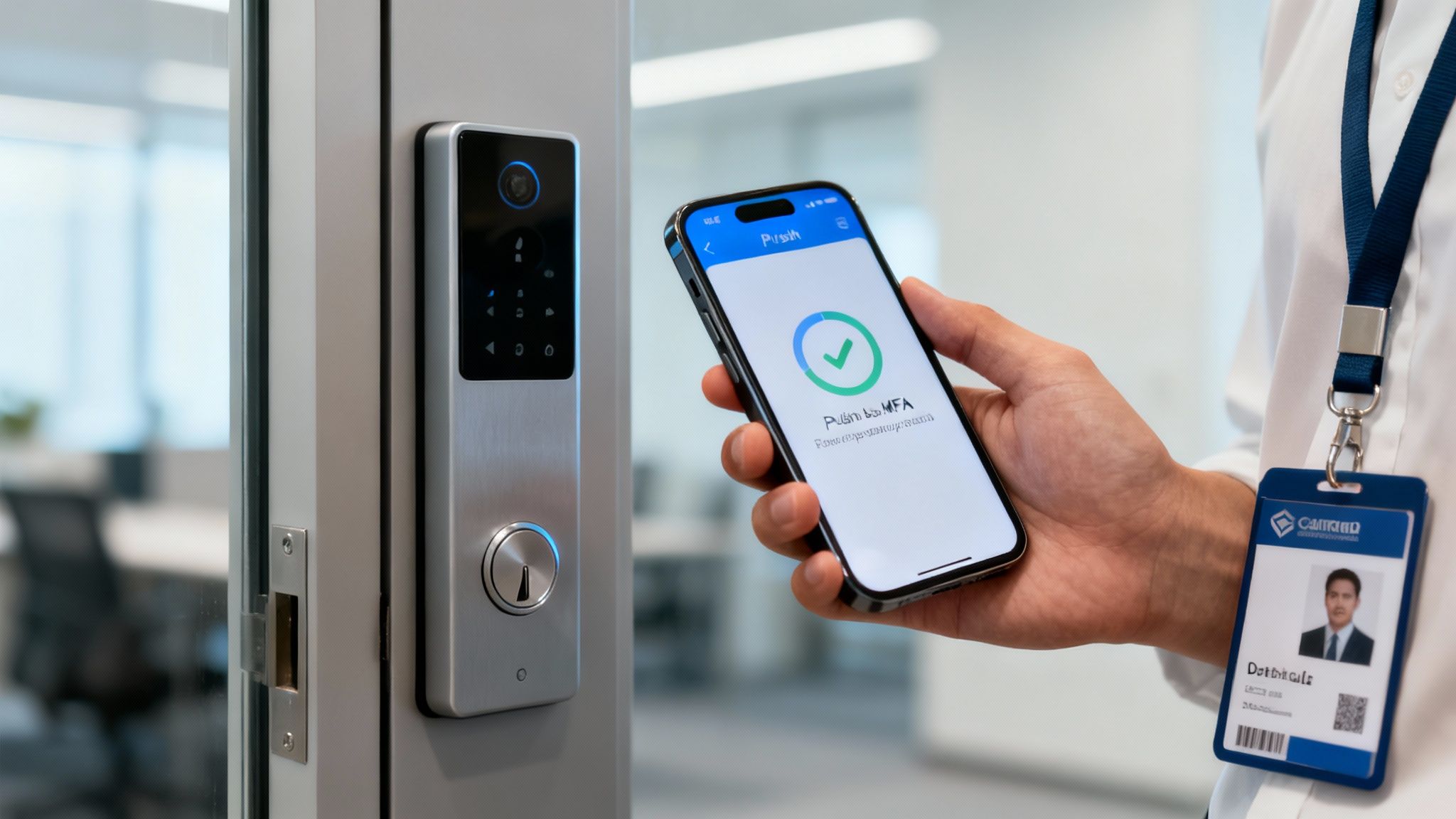In an era of relentless cyber threats, simply having security measures in place isn't enough. You need concrete proof that they are working as intended. An IT security audit is a systematic evaluation of your organization's information system, measuring how well it conforms to a set of established criteria. It’s the critical process that separates assuming you're secure from knowing you're secure. For small and mid-sized businesses, from law firms to dental practices, a proactive audit is not just a best practice; it's a fundamental business necessity.
A thorough audit acts as a diagnostic tool, systematically uncovering hidden vulnerabilities before they can be exploited. It ensures you are meeting crucial regulatory compliance standards like HIPAA or PCI DSS, and provides a clear, prioritized roadmap for strengthening your digital defenses. Neglecting this process leaves your sensitive client data, financial information, and business reputation dangerously exposed. The consequences of a breach go far beyond financial loss, often leading to a permanent loss of customer trust.
This comprehensive it security audit checklist is designed to be your guide. We will break down the 10 most critical domains you must scrutinize to build a truly resilient security posture. Moving beyond theory, we'll provide actionable steps and specific examples for each area, including:
- Access Control and Identity Management: Who can access what, and how do you prove it?
- Network Security: Is your perimeter truly secure against intrusion?
- Incident Response: What is your exact plan when an attack occurs?
- Vulnerability Management: How do you find and fix weaknesses before attackers do?
By following this checklist, you can move from a reactive to a proactive security stance, transforming your IT infrastructure from a potential liability into a fortified business asset.
1. Access Control and Identity Management
Access Control and Identity Management (IAM) is the foundational framework that determines who can access what within your organization's IT environment. This critical component of any IT security audit checklist ensures that only authorized individuals gain access to specific data, applications, and systems. It operates on the principle of least privilege, meaning users are granted only the minimum levels of access, or permissions, needed to perform their job functions.

Effective IAM prevents unauthorized access, data breaches, and insider threats by verifying identities and enforcing access policies. Modern systems like Microsoft Active Directory, Okta, and AWS IAM provide centralized platforms to manage user lifecycles from onboarding to offboarding, streamlining security administration and ensuring consistent policy application across the enterprise.
Key Audit Actions for Access Control
During your security audit, focus on verifying the following IAM components:
- Multi-Factor Authentication (MFA): Confirm that MFA is enabled for all critical systems, including email, VPN, and administrative accounts. This adds a vital layer of security beyond just passwords.
- Quarterly Access Reviews: Schedule and document regular reviews of user access rights. Managers should verify that their team members' permissions are still appropriate for their roles, removing any excessive or unnecessary access.
- Centralized Identity Repository: Ensure a single source of truth (like Active Directory) manages all user identities. This prevents fragmented, inconsistent, and insecure access control across different applications.
- Prompt Offboarding Process: Test the process for revoking access for terminated employees. Access to all systems, data, and physical locations must be removed immediately upon an employee's departure to mitigate risk. While strong IAM policies are crucial, they must be supported by robust password security. You can discover more about creating a secure foundation with these best practices for password management.
A robust IAM strategy is not a "set it and forget it" task; it requires continuous monitoring and adjustment as roles change and your organization evolves. By rigorously auditing these controls, you build a strong defense against unauthorized access.
2. Data Protection and Encryption
Data Protection and Encryption is a core component of any IT security audit checklist, focusing on safeguarding sensitive information from unauthorized access. This involves transforming readable data into an unreadable format using cryptographic algorithms, rendering it useless to anyone without the correct decryption key. It applies to data both "at rest" (stored on servers, laptops, or databases) and "in transit" (moving across the network or internet).

Effective encryption is the last line of defense; even if a cybercriminal bypasses other security controls and steals data, strong encryption ensures the information remains confidential and unusable. Modern tools like BitLocker for full-disk encryption on Windows or cloud services like AWS Key Management Service (KMS) make implementing robust encryption more accessible than ever. This process is crucial for maintaining regulatory compliance (e.g., HIPAA, GDPR) and protecting intellectual property.
Key Audit Actions for Data Protection
During your security audit, thoroughly examine and validate the following encryption and data handling controls:
- Data Classification Policy: Verify that a formal data classification policy exists. This policy should categorize data based on sensitivity (e.g., Public, Internal, Confidential, Restricted) to determine the required level of protection for each type.
- Encryption Standards: Confirm that strong, industry-accepted encryption algorithms are in use. This means AES-256 for data at rest and TLS 1.2 or higher for all data in transit. Outdated protocols like SSL and early TLS versions should be disabled.
- Key Management Procedures: Review your cryptographic key management processes. Ensure there are documented procedures for secure key generation, storage (ideally in a Hardware Security Module or HSM), rotation, and eventual destruction. Access to these keys must be strictly controlled.
- Full-Disk Encryption (FDE): Check that FDE is enabled on all company endpoints, especially laptops and mobile devices that could be lost or stolen. This protects all data stored on the device's hard drive from being accessed if the physical device is compromised.
A meticulous approach to data protection and encryption is non-negotiable in today's threat landscape. By systematically auditing these measures, you ensure your most valuable digital assets remain secure, regardless of where they are stored or how they are transmitted.
3. Network Security and Perimeter Defense
Network Security and Perimeter Defense forms the protective barrier around your organization's digital assets. This essential area of an IT security audit checklist focuses on securing the network infrastructure and its boundaries to block unauthorized access and detect malicious activity before it can cause harm. It employs a defense-in-depth strategy, layering multiple security controls to create a resilient and robust shield against external and internal threats.

Effective perimeter defense is no longer just about building a wall around your network; it's about creating intelligent, segmented, and continuously monitored environments. Modern security architectures, popularized by frameworks like the NIST Cybersecurity Framework and Palo Alto Networks' Zero Trust principles, utilize tools such as next-generation firewalls, intrusion prevention systems (IPS), and DDoS protection services. For instance, technologies like Palo Alto Networks firewalls provide application-level visibility, while services from Cloudflare mitigate large-scale denial-of-service attacks, ensuring your network remains available and secure.
Key Audit Actions for Network Security
When auditing your network security, concentrate on evaluating these critical components and practices:
- Layered Firewall and IPS Implementation: Verify that stateful firewalls are properly configured to inspect traffic and that an Intrusion Prevention System (IPS) is in place to actively block known threats. Ensure rules are reviewed regularly and align with business needs.
- Network Segmentation: Check that the network is segmented into distinct security zones (e.g., DMZ, production, development). This contains potential breaches by limiting an attacker's lateral movement. Microsoft Azure network security groups are a great example of implementing this in the cloud.
- Vulnerability Scanning and Penetration Testing: Confirm that regular, automated vulnerability scans are conducted on all network devices and systems. Additionally, schedule periodic penetration tests with third-party experts to simulate real-world attacks and identify weaknesses.
- Zero Trust Architecture Principles: Audit progress toward implementing a Zero Trust model, where no user or device is trusted by default. This involves verifying every access request, regardless of where it originates, and enforcing strict access controls across the entire network.
A well-defended perimeter is your first and most important line of defense. By methodically auditing these controls, you can significantly reduce your attack surface and protect critical infrastructure from compromise.
4. Vulnerability Management and Patch Management
Vulnerability and Patch Management is the proactive process of identifying, evaluating, treating, and reporting security vulnerabilities across your organization's systems and software. A critical part of any IT security audit checklist, this control ensures that known security gaps are closed before they can be exploited by attackers. It involves a continuous cycle of scanning for weaknesses, applying necessary updates (patches), and tracking remediation efforts.
Effective vulnerability management minimizes your attack surface and protects against widespread threats that target unpatched software. Tools like Qualys and Rapid7 InsightVM help automate the detection of vulnerabilities, while vendors like Microsoft and Adobe provide regular patch releases to fix them. A formalized process ensures these fixes are applied in a timely and systematic manner, preventing significant security incidents.
Key Audit Actions for Vulnerability and Patch Management
During your security audit, verify that a structured and consistent process is in place for managing vulnerabilities:
- Formal Patch Management Policy: Confirm there is a documented policy that defines the entire patching lifecycle. This should include timelines for applying patches based on severity, roles and responsibilities, and procedures for testing and deployment.
- Regular Vulnerability Scanning: Ensure that automated vulnerability scans are conducted regularly across all network assets. The audit should check scan schedules, the scope of assets covered, and the process for reviewing scan results.
- Prioritization Based on Risk: Check that vulnerabilities are prioritized for remediation using a standard system, such as the Common Vulnerability Scoring System (CVSS). Critical and high-severity vulnerabilities in internet-facing systems should receive immediate attention.
- Patch Testing and Deployment: Verify that patches are tested in a non-production environment before being deployed to live systems. This crucial step prevents updates from causing operational disruptions. The audit should also review the process for rolling back failed patches. To understand how this fits into a broader security framework, you can learn more about implementing the NIST Cybersecurity Framework.
A systematic approach to finding and fixing flaws is non-negotiable for modern cybersecurity. By rigorously auditing your patch management procedures, you ensure your defenses remain strong against evolving threats.
5. Incident Response and Management
Incident Response and Management is the organizational framework for preparing for, detecting, containing, and recovering from a security breach. This essential part of an IT security audit checklist ensures you have a clear, actionable plan to minimize damage, reduce recovery time, and prevent future occurrences when an incident happens. A well-defined plan moves your team from a state of panic to a structured, effective response.
Effective incident response plans are critical for business continuity. For instance, the Microsoft Security Response Center (MSRC) has established a robust public framework for handling vulnerabilities and threats, demonstrating how a mature program can manage incidents at a massive scale. A formal plan ensures all stakeholders understand their roles and responsibilities, enabling a coordinated effort to control the situation and restore normal operations swiftly.
Key Audit Actions for Incident Response
During your security audit, verify that your incident response capabilities are both documented and tested:
- Formal Incident Response Plan (IRP): Confirm the existence of a documented IRP that outlines specific steps for different incident types (e.g., malware, data breach, DDoS attack). The plan should define phases like preparation, identification, containment, eradication, recovery, and lessons learned.
- Designated Response Team: Ensure a dedicated Computer Security Incident Response Team (CSIRT) is established with clearly defined roles, responsibilities, and contact information. This team should include members from IT, legal, communications, and management.
- Regular Plan Testing: Check for records of incident response testing, such as tabletop exercises or full-scale simulations. These tests are crucial for identifying gaps in the plan and ensuring the team is prepared to execute it under pressure.
- Post-Incident Review Process: Verify that a formal process exists for conducting a post-incident review or "lessons learned" session within a set timeframe, typically 30 days. The goal is to analyze the response, identify weaknesses, and implement improvements to strengthen future security. You can find more insights on building a resilient security posture by exploring these cybersecurity best practices.
Without a tested incident response plan, an organization is left scrambling during a crisis, leading to greater financial loss, reputational damage, and prolonged downtime. Regularly auditing this function turns it from a theoretical document into a practical, life-saving tool for your business.
6. Security Awareness and Training
Security Awareness and Training is the critical human layer of your defense strategy. This component of any comprehensive IT security audit checklist ensures that employees understand their role in protecting company assets and can recognize, report, and respond to potential threats. It aims to build a security-conscious culture where every team member acts as a vigilant defender against cyberattacks.
Effective training transforms your workforce from a potential vulnerability into a powerful security asset. Platforms like KnowBe4 and Proofpoint provide structured programs that move beyond simple compliance, using engaging content and realistic phishing simulations to equip staff with practical skills. By fostering this awareness, organizations significantly reduce the risk of human error, which is a leading cause of data breaches.
Key Audit Actions for Security Awareness
During your security audit, verify the effectiveness of your training program by examining the following elements:
- Mandatory Annual Training: Confirm that all employees, including executives and contractors, complete security awareness training upon hiring and at least annually thereafter. Document completion rates and follow up on any delinquencies.
- Regular Phishing Simulations: Check for a consistent program of simulated phishing attacks. Review the metrics from these tests, such as click rates and reporting rates, to measure program effectiveness and identify areas for improvement.
- Role-Specific Training: Ensure that training content is tailored to different job functions. For example, developers should receive training on secure coding practices, while finance teams need specific education on preventing business email compromise (BEC) and wire fraud.
- Clear Incident Reporting Procedures: Verify that employees know exactly how and when to report a suspected security incident. Test this process to ensure reports are received and acted upon promptly by the IT or security team.
A well-executed training program is not a one-time event but an ongoing effort to maintain a high level of security vigilance. Auditing these activities ensures your human firewall remains strong and adaptive to new threats.
7. Logging, Monitoring, and Audit Trails
Logging, Monitoring, and Audit Trails are the cornerstone of a proactive security posture, providing the visibility needed to detect, investigate, and respond to potential threats. This critical element of any IT security audit checklist involves capturing event logs from all systems, applications, and network devices to create a comprehensive record of activity. The goal is to establish a clear audit trail that provides accountability and insight into security-relevant events.
Effective logging and monitoring allow security teams to identify suspicious activities in real time, investigate incidents after they occur, and prove compliance with regulatory standards. Modern Security Information and Event Management (SIEM) systems like Microsoft Sentinel, Splunk, and IBM QRadar centralize logs from disparate sources, correlating data to uncover patterns that might indicate a sophisticated attack, such as repeated failed login attempts followed by a successful one from an unusual location.
Key Audit Actions for Logging and Monitoring
To ensure your logging and monitoring framework is effective, your security audit should validate the following controls:
- Centralized Log Management: Verify that a SIEM or a centralized logging solution is in place to collect, parse, and store logs from all critical assets. This consolidation is essential for correlating events across your entire IT environment.
- Comprehensive Log Coverage: Ensure that logging is enabled for all critical systems, including servers, firewalls, applications, and databases. Audit what is being logged to confirm it captures security-relevant events like logins, access changes, and administrative actions.
- Real-Time Alerting: Confirm that automated alerts are configured for high-priority security events, such as potential malware infections, unauthorized access, or significant configuration changes. Test these alerts to ensure they are timely and actionable.
- Log Retention and Integrity: Review your log retention policy to ensure it meets both business and compliance requirements, often a minimum of one year. Check that measures are in place to protect logs from tampering or unauthorized deletion. Understanding which systems to monitor is a foundational step, and you can explore some of the best network monitoring tools to build out your capabilities.
A well-audited logging and monitoring system acts as your organization’s digital surveillance, providing the evidence needed to understand and thwart security threats before they escalate into major breaches.
8. Secure Configuration Management
Secure Configuration Management is the systematic process of establishing and maintaining consistent, secure settings for your organization's hardware and software. This essential part of any IT security audit checklist focuses on hardening systems against attack by eliminating vulnerabilities introduced through default or weak configurations. It operates on the principle of creating a secure baseline, a standardized "gold image" of settings that all systems must adhere to, minimizing the attack surface.
Effective configuration management prevents security gaps caused by misconfigured servers, applications, and network devices. By enforcing standardized security policies, it reduces the risk of unauthorized changes and configuration drift, where systems slowly deviate from their secure state over time. Frameworks like the CIS (Center for Internet Security) Benchmarks and DISA STIGs (Security Technical Implementation Guides) provide detailed, consensus-based guidelines for hardening a wide range of technologies.
Key Audit Actions for Secure Configuration
During your security audit, focus on verifying the following configuration management components:
- Establish a Secure Baseline: Confirm that documented security baselines, such as those from CIS or NIST, exist for all critical operating systems, applications, and network devices. All new deployments must adhere to these standards.
- Implement Configuration Management Tools: Verify the use of tools like Ansible, Puppet, or Microsoft Group Policy to automate the deployment and enforcement of secure configurations. This ensures consistency and reduces manual errors.
- Scan for Configuration Drift: Ensure that regular, automated scans are performed to detect any deviations from the established security baseline. Your audit should check the process for remediating these discrepancies promptly.
- Control and Document Changes: Review the change management process. All configuration changes must be documented, tested in a non-production environment, and approved before being deployed. Version control for configuration files is a critical part of this process.
A disciplined approach to configuration management ensures that your systems are not only deployed securely but remain secure throughout their lifecycle. By rigorously auditing these controls, you build a resilient defense against common exploits targeting misconfigurations.
9. Third-Party and Vendor Risk Management
Third-Party and Vendor Risk Management is the process of identifying, assessing, and mitigating security risks introduced by external partners, suppliers, and service providers. In an interconnected business environment, your security is only as strong as your weakest link, and often that link is a third-party vendor with access to your systems or data. A key part of any IT security audit checklist is ensuring these external entities adhere to your organization's security standards.
Effective vendor management protects your organization from data breaches, supply chain attacks, and compliance violations originating from outside your direct control. By establishing clear security expectations and continuous monitoring, you create a resilient ecosystem. Notable examples, like the Target data breach in 2013 which originated through an HVAC vendor, highlight the critical need for a structured approach to managing third-party risk.
Key Audit Actions for Vendor Risk Management
During your security audit, verify that a comprehensive vendor management program is in place and actively followed:
- Vendor Risk Categorization: Confirm that vendors are categorized based on their access to sensitive data and systems (e.g., high, medium, low risk). High-risk vendors, like cloud service providers or payment processors, should undergo more stringent scrutiny.
- Security in Contracts: Review vendor contracts to ensure they include specific security clauses. These should detail data handling responsibilities, incident notification timelines (e.g., within 24 hours of discovery), and the right to audit their security controls.
- Standardized Security Assessments: Ensure a formal process exists for vetting new vendors. This often involves sending a standardized security questionnaire and requesting compliance reports like a SOC 2 Type II, which validates their security controls over time.
- Ongoing Monitoring: Check for evidence of continuous monitoring of critical vendors. This includes reviewing their security incident reports, staying informed of breaches affecting them, and conducting periodic reassessments to ensure they remain compliant with your security requirements.
A proactive vendor risk management program is essential for protecting your organization's data and reputation. It transforms a potential area of significant vulnerability into a managed and fortified component of your overall security strategy.
10. Business Continuity and Disaster Recovery
Business Continuity and Disaster Recovery (BCDR) is the strategic framework that ensures an organization can continue essential operations during and after a significant disruption. This vital element of any IT security audit checklist addresses how to recover from security incidents, natural disasters, or technical failures. It focuses on minimizing downtime and data loss, thereby protecting revenue, reputation, and operational stability.
An effective BCDR plan is not just about data backups; it encompasses the people, processes, and technologies required to restore business functions. Major cloud providers like AWS and Microsoft Azure offer robust, geographically dispersed infrastructure for creating resilient systems that can failover automatically. By planning for the worst-case scenario, businesses can transform a potential catastrophe into a manageable incident.
Key Audit Actions for Business Continuity
During your security audit, focus on verifying the following BCDR components:
- RPO and RTO Objectives: Confirm that clear Recovery Point Objectives (RPO) and Recovery Time Objectives (RTO) are defined and documented. RPO dictates the maximum acceptable data loss, while RTO sets the target time for restoring operations.
- Regular Plan Testing: Ensure the disaster recovery plan is tested at least quarterly. These tests, ranging from tabletop exercises to full failover simulations, should be documented to identify and address weaknesses.
- Off-site Encrypted Backups: Verify that critical data is backed up regularly, encrypted, and stored in a secure, geographically separate location. This protects against localized disasters like fires or floods.
- Documented Recovery Procedures: Check for comprehensive, up-to-date documentation that provides step-by-step instructions for recovery. Key personnel should have easy access to these procedures during an emergency. For a deeper dive into safeguarding your data, review these essential best practices for data backup and recovery.
A well-audited BCDR strategy provides confidence that your business can withstand unforeseen events. It requires ongoing review and adjustment to ensure it remains effective as your technology and business processes evolve.
10-Point IT Security Audit Checklist Comparison
| Control Area | Implementation Complexity 🔄 | Resource Requirements ⚡ | Expected Outcomes ⭐📊 | Ideal Use Cases 💡 | Key Advantages ⭐ |
|---|---|---|---|---|---|
| Access Control and Identity Management | High 🔄 — cross-system integration | Moderate–High ⚡ — IAM platform + ops | Strong prevention of unauthorized access; improved auditability ⭐📊 | Workforce authentication, SSO, privileged access control 💡 | Enforces least privilege; rapid deprovisioning; audit trails ⭐ |
| Data Protection and Encryption | Moderate–High 🔄 — key management complexity | Moderate ⚡ — compute, KMS/HSMs | Confidentiality preserved; regulatory compliance; unusable stolen data ⭐📊 | Sensitive data storage/transit; regulated datasets (HIPAA, GDPR) 💡 | Protects data at rest/in transit; compliance alignment ⭐ |
| Network Security and Perimeter Defense | High 🔄 — architecture & tuning | High ⚡ — appliances, monitoring, skilled staff | Blocks malicious network traffic; improved visibility and response ⭐📊 | Hybrid networks, internet-facing services, DDoS protection 💡 | Reduces attack surface; real-time traffic control and detection ⭐ |
| Vulnerability & Patch Management | Moderate 🔄 — scanning + remediation workflows | Moderate ⚡ — scanners, test environments, automation | Fewer exploitable vulnerabilities; proactive risk reduction ⭐📊 | Frequent software updates, large software estates, compliance needs 💡 | Identifies and remediates gaps; supports compliance evidence ⭐ |
| Incident Response and Management | High 🔄 — coordinated teams & processes | High ⚡ — SOC, forensic tools, trained staff | Faster containment and recovery; lessons learned for future incidents ⭐📊 | High-impact incidents, critical infrastructure, regulated orgs 💡 | Minimizes damage; accelerates recovery; improves resilience ⭐ |
| Security Awareness and Training | Low–Moderate 🔄 — program design & cadence | Low–Moderate ⚡ — LMS, simulation tools | Reduced human error; improved reporting and detection of social attacks ⭐📊 | All staff, customer-facing teams, phishing-prone orgs 💡 | Cost-effective behaviour change; increases reporting rates ⭐ |
| Logging, Monitoring, and Audit Trails | Moderate–High 🔄 — SIEM integration & tuning | High ⚡ — storage, correlation engines, analysts | Real-time detection; forensic evidence; compliance support ⭐📊 | Compliance-driven environments, SOC operations, forensic needs 💡 | Enables detection & investigation; maintains non-repudiable logs ⭐ |
| Secure Configuration Management | Moderate 🔄 — baselines, IaC, drift control | Moderate ⚡ — automation tools, scanning | Consistent secure configurations; fewer misconfigurations ⭐📊 | Large-scale infra, IaC deployments, regulated systems 💡 | Reduces configuration drift; speeds secure deployments ⭐ |
| Third-Party & Vendor Risk Management | Moderate 🔄 — assessments, contractual controls | Moderate ⚡ — questionnaires, monitoring, audits | Reduced supply-chain risk; better vendor accountability ⭐📊 | Organizations with many vendors or critical suppliers 💡 | Extends security to ecosystem; enforces contractual security ⭐ |
| Business Continuity & Disaster Recovery | High 🔄 — planning, testing, coordination | High ⚡ — redundancy, backups, alternate sites | Minimized downtime; defined RPO/RTO; restored operations post-disruption ⭐📊 | Critical services, financial services, high-availability systems 💡 | Ensures operational resilience and trusted recovery ⭐ |
From Checklist to Action: Partnering for Proactive Security
Navigating the extensive domains of an it security audit checklist, from Access Control and Data Protection to Incident Response and Third-Party Risk Management, is a monumental achievement. You have taken a crucial first step towards fortifying your organization's digital defenses. This comprehensive review provides a clear, high-resolution snapshot of your current security posture, illuminating both your strengths and, more critically, the vulnerabilities that require immediate attention.
However, the true measure of a successful audit is not the completed checklist itself, but the decisive action that follows. A list of identified gaps in patch management, weaknesses in network configuration, or untested disaster recovery plans is merely a diagnosis. The remedy lies in a sustained, strategic, and often complex implementation process. For small to mid-sized businesses, professional practices like law firms or dental offices, the resource and expertise gap between diagnosis and remedy can feel vast and overwhelming.
Turning Audit Findings into Actionable Strategy
The journey from checklist to a robust security framework involves transforming findings into a prioritized action plan. This is where strategic thinking becomes paramount. Not all vulnerabilities carry the same weight; a critical flaw in your network perimeter defense likely poses a more immediate threat than a minor lapse in documentation.
Consider these immediate next steps to translate your audit into tangible results:
- Prioritize with a Risk Matrix: Categorize each finding based on its potential impact on your business and the likelihood of exploitation. A simple matrix (High/Medium/Low Impact vs. High/Medium/Low Likelihood) can help you focus resources on the most critical threats first. For example, an unpatched server hosting sensitive client data (High Impact, High Likelihood) should be addressed before updating the security awareness training a month ahead of schedule (Medium Impact, Low Likelihood).
- Develop a Remediation Roadmap: Create a clear, time-bound plan for addressing each identified issue. Assign ownership to specific individuals or teams, set realistic deadlines, and define what "resolved" looks like for each item. This roadmap turns your audit from a static document into a dynamic project plan.
- Integrate, Don't Isolate: Security is not a one-time project; it's an ongoing process. Use the insights from your it security audit checklist to refine your daily operations. For instance, if you discovered inconsistent access controls, implement a quarterly review process for all user permissions. If logging was insufficient, integrate regular log analysis into your IT team's weekly tasks.
The Value of Continuous Improvement and Expert Partnership
Mastering these concepts is not just about avoiding a data breach; it's about building a resilient organization. A proactive security posture enhances client trust, ensures regulatory compliance, and protects your business's reputation and financial stability. It transforms IT from a cost center into a strategic enabler, allowing you to operate with confidence in an increasingly complex digital landscape.
However, the reality for many businesses is that the in-house expertise or sheer bandwidth to execute a comprehensive remediation plan simply doesn't exist. Managing firewall rules, monitoring for threats 24/7, and staying ahead of emerging vulnerabilities is a full-time job requiring specialized skills. This is precisely where a strategic partner becomes invaluable. An expert IT provider can take the weight of implementation off your shoulders, transforming your audit findings into a fully managed, continuously improving security program. They bring the tools, processes, and experience necessary to not only fix current issues but also to anticipate and prevent future ones.
By moving beyond the checklist, you shift from a reactive stance of fixing problems to a proactive culture of security. This journey ensures that your digital assets, client data, and business continuity are not left to chance but are protected by a deliberate, robust, and professionally managed strategy.
Completing an it security audit checklist is the first step, but implementing and managing the solutions is a continuous effort. GT Computing specializes in transforming audit findings into a robust, managed security strategy, allowing you to focus on your core business without worrying about the complexities of cybersecurity.
Keep your business running without IT headaches.
GT Computing provides fast, reliable support for both residential and business clients. Whether you need network setup, data recovery, or managed IT services, we help you stay secure and productive.
Contact us today for a free consultation.
Call 203-804-3053 or email Dave@gtcomputing.com


